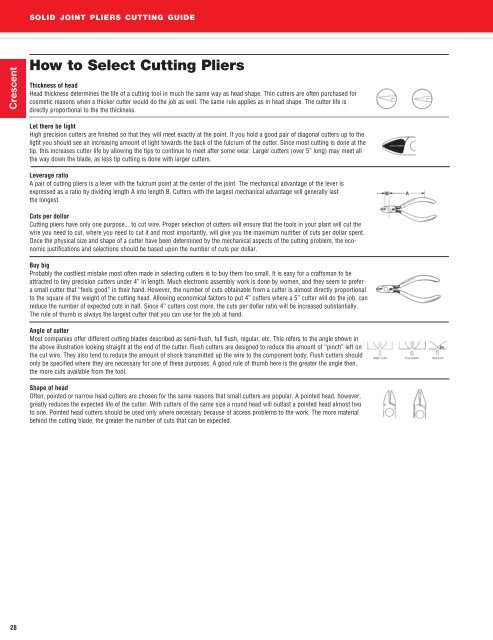You also want an ePaper? Increase the reach of your titles
YUMPU automatically turns print PDFs into web optimized ePapers that Google loves.
SOLID JOINT PLIERS CUTTING GUIDE<br />
<strong>Crescent</strong><br />
How to Select Cutting Pliers<br />
Thickness of head<br />
Head thickness determines the life of a cutting tool in much the same way as head shape. Thin cutters are often purchased for<br />
cosmetic reasons when a thicker cutter would do the job as well. The same rule applies as in head shape. The cutter life is<br />
directly proportional to the the thickness.<br />
Let there be light<br />
High precision cutters are finished so that they will meet exactly at the point. If you hold a good pair of diagonal cutters up to the<br />
light you should see an increasing amount of light towards the back of the fulcrum of the cutter. Since most cutting is done at the<br />
tip, this increases cutter life by allowing the tips to continue to meet after some wear. Larger cutters (over 5” long) may meet all<br />
the way down the blade, as less tip cutting is done with larger cutters.<br />
Leverage ratio<br />
A pair of cutting pliers is a lever with the fulcrum point at the center of the joint. The mechanical advantage of the lever is<br />
expressed as a ratio by dividing length A into length B. Cutters with the largest mechanical advantage will generally last<br />
the longest.<br />
Cuts per dollar<br />
Cutting pliers have only one purpose... to cut wire. Proper selection of cutters will ensure that the tools in your plant will cut the<br />
wire you need to cut, where you need to cut it and most importantly, will give you the maximum number of cuts per dollar spent.<br />
Once the physical size and shape of a cutter have been determined by the mechanical aspects of the cutting problem, the economic<br />
justifications and selections should be based upon the number of cuts per dollar.<br />
Buy big<br />
Probably the costliest mistake most often made in selecting cutters is to buy them too small. It is easy for a craftsman to be<br />
attracted to tiny precision cutters under 4” in length. Much electronic assembly work is done by women, and they seem to prefer<br />
a small cutter that “feels good” in their hand. However, the number of cuts obtainable from a cutter is almost directly proportional<br />
to the square of the weight of the cutting head. Allowing economical factors to put 4” cutters where a 5” cutter will do the job, can<br />
reduce the number of expected cuts in half. Since 4” cutters cost more, the cuts per dollar ratio will be increased substantially.<br />
The rule of thumb is always the largest cutter that you can use for the job at hand.<br />
Angle of cutter<br />
Most companies offer different cutting blades described as semi-flush, full flush, regular, etc. This refers to the angle shown in<br />
the above illustration looking straight at the end of the cutter. Flush cutters are designed to reduce the amount of “pinch” left on<br />
the cut wire. They also tend to reduce the amount of shock transmitted up the wire to the component body. Flush cutters should<br />
only be specified where they are necessary for one of these purposes. A good rule of thumb here is the greater the angle then,<br />
the more cuts available from the tool.<br />
Shape of head<br />
Often, pointed or narrow head cutters are chosen for the same reasons that small cutters are popular. A pointed head, however,<br />
greatly reduces the expected life of the cutter. With cutters of the same size a round head will outlast a pointed head almost two<br />
to one. Pointed head cutters should be used only where necessary because of access problems to the work. The more material<br />
behind the cutting blade, the greater the number of cuts that can be expected.<br />
28

















